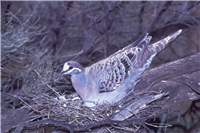Family
Columbidae
Genus
Phaps
Species
chalcoptera
Threats/Control Methods - Regional
Searching for permanent water sources may force the species to less favourable habitats, where there is less vegetation and an increased risk of predation from Dogs (Canis familiaris) and Cats (Felis catus).
Threats/Control Methods - Local
Prolonged periods of drought will inhibit this species from breeding successfully, limiting population numbers. Land clearing, grazing and weed dispersal also threaten their woodland habitat.
Local/Urban Actions
The Bronzewing may visit garden birdbaths if the area is free from anything that might startle these shy birds, including other more aggressive birds or domestic pets. It also requires layers of trees, shrubs and ground cover. The birds are only likely to visit suburbs near nature reserves and pet owners in these regions can limit the risk of predation by keeping pets on a leash and providing them with a stimulating indoor or enclosed area.
Common Names
Common Bronzewing, Forest Bronzewing, Bronzewing
Distinguishing Features
The Common Bronzewing is a bulky bird with a comparatively small head, 30-36cmm in size. Their neck and back is a brown-grey colour and they are most distinct due to the multicoloured iridescent patch on their wings. They also have a distinct white stripe under their eye and a blue coloured neck, which blends into their pinkish-grey breast. The blue colour in females is far paler. The legs and feet are a bright pink-red colour. In flight, the rusty red colour of the underwings is noticeable. Young birds are dull and lack the colourful wing patch.
Survey Techniques
Call and visual identification.
Species Call
A deep 'oom' repeated several times.
Similar Species
The Rock Dove (Columba livia ) is slightly larger and greyer in colour. The Crested Pigeon (Ocyphaps lophotes ) is distict because of the tall crest on its head.
Distribution
This species is found fairly commonly across the entire Australian mainland, excluding only the most arid regions.
Country of Origin
Australia
Conservation (Pet/Pest) Status - Regional
Population numbers have increased in recent years, as birds have moved into the suburbs from nearby forests (Veerman and COG).
Conservation (Pet/Pest) Status - National
Secure, not listed under the EPBC Act 1999
LSCCES Population
Birds were recorded at CSIRO and the ANBG.
Associated vegetation community
This species inhabits a diverse range of environments, including tropical rainforest, coastal open forest, woodland, farmland, alpine areas and arid mallee.
Limiting Resources
This species is found in a very diverse range of habitats, however it is only found in areas with understory vegetation of logs and shrubs. It is less suited to suburban environments, however they will move into less-prefered environments to be close to easily accessable water, as they are one of the most water-dependant bird species.
Breeding
The Common Bronzewing builds a rough platform of twigs at a variety of heights, on tree forks, tree stumps or on old nest of a Magpie (Gymnorhina tibicen ). Two white eggs are laid and then incubated for 15 days by both parents. The young are born helpless and naked and are completely dependant on their parents.
Behaviour
This species is very shy and cautious. It will fly away if approached, keeping low to the ground. They can be seen alone or in small flocks.
Functional Group
Food Species
This bird easts a variety of seeds and vegetable matter.
Predators
Feral animals such as the European Red Fox (Vulpes vulpes), or Cats (Felis catus) may attack this species and young birds are especially vulnerable.
Interesting Fact
Bronzewings secrete a special milk-like substance, which is fed to the young chicks.
References - (reader suitability of references, P=Primary teachers, S=Secondary students, T=Tertiary students and researchers)
Books:Freudenberger, D. 2001. Bush for the birds: Biodiversity enhancement guidelines for the Saltshaker Project, Boorowa, NSW. Consultancy report to Greening Australia ACT and SE NSW Inc. CSIRO Sustainable Ecosystems. Canberra. S, T
Morcombe, M. 2000. Field Guide to Australian Birds. Steve Parish Publishing. Archerfield. Australia P, S, T
Schodde, R. and Tideman, S. (eds) 1990. Reader's Digest Complete Book of Australian Birds (2nd Edition). Reader's Digest Services Pty Ltd. Sydney. P, S, T
Veerman, P. 2003. Canberra Birds: A report on the first 21 years of the garden bird survey. Philip Veerman and Canberra Ornithologists Group. Canberra. S, T
Internet: Birds in Backyards. 2006. [online]. Available at:http://www.birdsinbackyards.net P, S, T
Canberra Ornithological Group (COG). 2004. Birds of Canberra Gardens. COG and the ACT Department of Urban Services. [online]. Available at:http://garden.canberrabirds.org.au/ P, S, T
Online Publications: Nix, H. and Cunningham, R. 2006. Birds of the Lower Sullivans Creek Catchment, Canberra ACT. Prepared for the Life in the Suburbs project using data from the Lower Sullivans Creek Catchment Ecological Survey (LSCCES). Australian National University. Canberra. [online]. Available at: http://www.lifeinthesuburbs.com.au/category.php?id=65 S, T
Olsen, P. and Weston, M. 2004. The State of Australia's Birds 2004: Water, wetlands and birds. Birds Australia. [online]. Available at: http://www.environment.gov.au/biodiversity/publications/birds-04/threats.html S, T

 Top
Top Top
Top